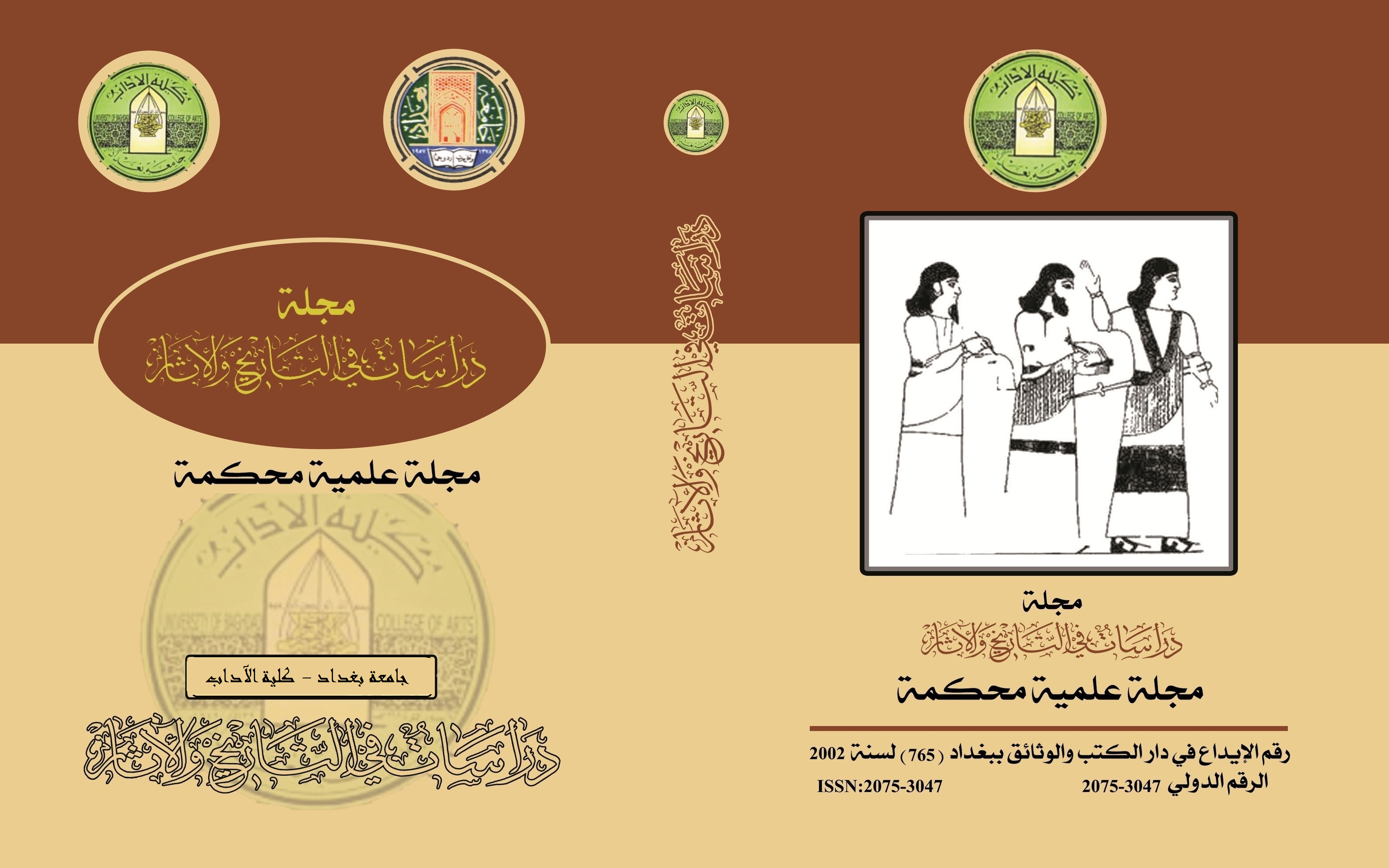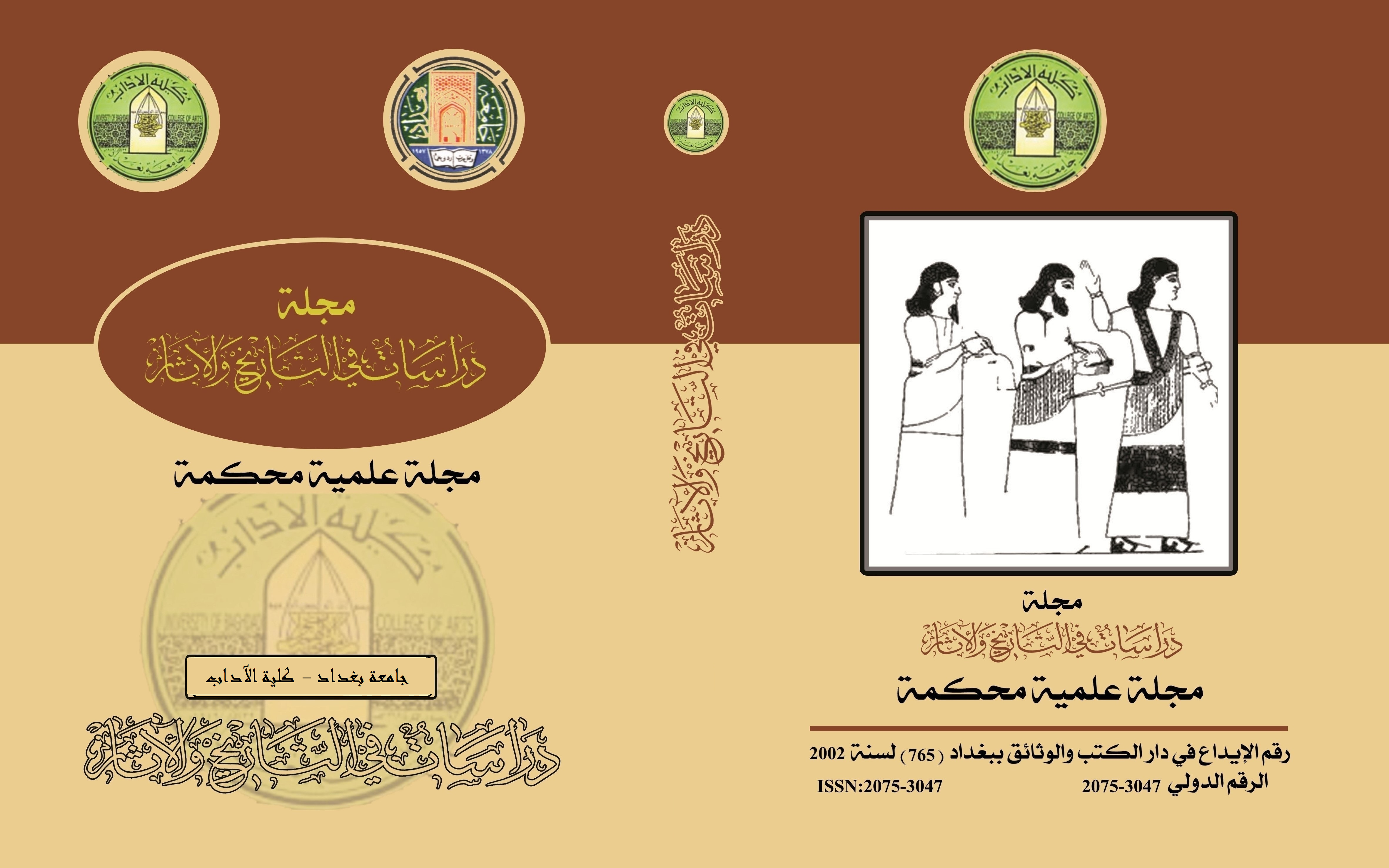عادات وطرائق الدفن في بلاد الأناضول
الكلمات المفتاحية:
عادات الدفن، العصر الحجري الحديث المبكر، مبنى الجماجم، زاكروسالملخص
يعد الدفن من أقدم العادات البشرية المكتسبة لدى الانسان وكيفية تعامله مع جثة المتوفى أذ تكشف عادات الدفن عن زوايا مهمة من المعتقدات الروحية والدينية لدى المجتمعات القديمة وتطور تلك العملية من القبور البسيطة الى الدفن تحت ارضيات السكن وتحولها من بعد ذلك الى الدفن في مقابر خاصة ومن ثم الدفن في مباني معدة لهذا الغرض او تخصيص جزء من المستوطن ليكون الموقع المخصص للمقبرة، اذ تعكس كل مرحلة من هذه المراحل جوانبا فكرية مهمة وتشير بدورها الى الترابط الفكري والروحي فضلا عن العلاقات الاقليمية التي تربط فيما بين مواقع العصر الحجري الحديث في عموم منطقة زاكروس الممتدة عبر تركيا والعراق وايران حالياً مع التأكيد على منطقة القسم الغربي من بلاد الاناضول القديمة. ويناقش البحث عددا من الفرضيات المتعلقة بعملية الدفن بمراحله المختلفة مع التأكيد على حالة مباني الموتى أو الجماجم التي انتشرت بشكل واضح في مواقع العصر الحجري في بلاد الاناضول وانتشرت منها الى بلاد الرافدين ومحاولة تفسير هذه الممارسة التي كانت تفسر على انها "عبادة الأسلاف" او لربما لها علاقة بعملية التضحيات أو التقدمات البشرية التي كانت تقدم لأله أو طوطم معين في القرية لضمان الامدادت والموارد الغذائية لأبناء القرية خاصة مع التطور الاقتصادي الجديد المتمثل بالزراعة البسيطة واولى محاولات التدجين خاصة مع استمرار هذه الشعيرة لمدة تقارب الالف عام في موقع تشايونو.
المراجع
Arbuckle. B, Ozkaya. V, Animal Exploitation at Kortik Tepe: An Early Aceramic Neolithic Site in Southeastern Turkey, (Paléorient:2006).
Benz. M, Deckers. K, Ozkaya. V, Prelude to Village Life, Environmental Data and Building Traditions of the Epipalaeolithic Settlement at Kortik Tepe, Southeastern Turkey, (Paléorient:2015).
Brady. J, Ground Stone Continuity and Change at Catalhoyuk, (Chronika:2017).
Coban. M, Guneydogu ve Orta Anadolu Bolgelrinde Neolitik Donemde Konut ve Hane, (Edirne:2017).
Croucher. K, Death, Display and Performance: A Discussion of the Mortuary Remains at Cayonu Tepesi, (St. Petersburg: 2006).
Croucher. K, The Archaeology of Cult and Death, (Russia:2003).
Dimitrios. S, Dating Gobekli Tepe, (University of Texas:2016).
During. B, Building Continuity in the Central Anatolian Neolithic: Exploring the Meaning of Buildings at Asikli Hoyuk and Catalhoyuk, (Netherland:2005).
Erdim. D, Social Differentiations in Cayonu and Abu Hureyra Through Burial Customs and Skeletal Biology, (Turkey: 2006).
Ezgi. N, Kazanci. D, Aydogan. A & Others, A Genomic Snapshot of Demographic and Cultural Dynamism in Upper Mesopotamia During the Neolithic Transition, (Turkey: 2022).
Gokhan. M, Guneydogo Ve Orta Anadolu Bolgerinde Neolitik Donem’De Konut Ve Hane, (Edirne:2017).
Hakly. G, Gopher. A, Geometry and Architectural Planning at Gobekli Tepe, Turkey, (Cambridge Archaeological Journal:2019).
Hamblin. D, The First Cities, The Shrines of CatalHoyuk, (Harvard:1973).
Konienko.T, On the Problem of Human Sacrifice in Northern Mesopotamia in the Pre-Pottery Neolithic, (Paleonvironment:2015).
Larsen. C, Knusel. C, Haddow. S & Others, Bioarcheology of Neolithic Catalhoyuk Reveals Fundamental Transitions in Health, Mobility and Lifestyle in Early Farmers, (PNAS:2019).
Lichter. C, Burial Customs of the Neolithic in Anatolia- An Over View, (Anatolian Metal VII:2016).
Mellart. J, Catal Huyuk, A Neolithic Town in Anatolia, (New York:1967).
Merve. G, Cafer Hoyuk Ve Degirmentepe Ortacag Topluluklarinin Karsilastirmali Antropolitik, (Ankara:2019).
Oksuz. B, Analysis of the cattle Bones of the Pre-pottery Neolithic Settlement of Cayonu, (Netherland:2000.
Oliver. D, Gobekli Tepe- First 20 Years of Research, German Archaeological Institute, (Berlin:2016).
Pearson. J, Grove. M, Ozbek. M, Hongo. H, Food and Social Complexity at Cayonu Tepesi, Southeastern Anatolia: Stable Isotope Evidence of Differentiations in Diet According to Burial Practice and Sex in the Early Neolithic, (Journal of Anthropological Archaeology: 2013).
Rega. M, “The Decapitation Ritual and the Ancient Maya Ballgame. From Archaeological Evidence to Sacred Stories, (Rome:2019).
Schmidt. K, Gobekli Tepe, The Neolithic in Turkey, (Istanbul:2011).
Schmidt. K, Gobekli Tepe: A Neolithic Site in Southeastern Anatolia, (Oxford:2011).
Taskiran. H, Tirpan. A, Canak Comleksgs Neolitik Donem, (Konya:2011).
Tatlock. J, Child Sacrifice in the Ancient Near and Middle East, (Oxford:2023).
المصادر العربية:
الجاسم، صباح عبود، مرحلة الانتقال من جمع القوت الى انتاج القوت في العراق وجنوب غرب آسيا، (بغداد:1975).
الجميلي، قصي صبحي عباس، الغانمي، فاتن منصور،الزمان والمكان في المشاهد الفنية على الرسوم الجدارية،(مجلة دراسات في التاريخ والاثار:2019).
الطلبي، جمعة، التحول في مخطط البيت من الدائري الى المستطيل في العصر الحجري الحديث في اعالي بلاد الرافدين، (عين شمس:2020).
علي، فاضل عبد الواحد،سومر فكر و معتقد،(بغداد:2021).
وائل حسن حمامرة، أريحا "تل السلطان" خلال العصر الحجري الحديث ما قبل الفخار (أ) (8500-7500 قبل الميلاد)، (حولية الاتحاد العام للآثاريين العرب:2023).
التنزيلات
منشور
إصدار
القسم
الرخصة

هذا العمل مرخص بموجب Creative Commons Attribution 4.0 International License.
:حقوق الطبع والنشر والترخيص
بالنسبة لجميع البحوث المنشورة في مجلة دراسات في التاريخ والآثار، يحتفظ الباحثون بحقوق النشر. يتم ترخيص البحوث بموجب ترخيص Creative Commons CC BY 4.0 المفتوح ، مما يعني أنه يجوز لأي شخص تنزيل البحث وقراءته مجانًا. بالإضافة إلى ذلك ، يجوز إعادة استخدام البحث واقتباسه شريطة أن يتم الاستشهاد المصدر المنشور الأصلي. تتيح هذه الشروط الاستخدام الأقصى لعمل الباحث وعرضه.
:إعادة إنتاج البحوث المنشورة من الناشرين الآخرين
من الضروري للغاية أن يحصل الباحثون على إذن لإعادة إنتاج أي بحث منشورة (أشكال أو مخططات أو جداول أو أي مقتطفات من نص) لا يدخل في نطاق الملكية العامة أو لا يملكون حقوق نشرها. يجب أن يطلب الباحثون إذنًا من مؤلف حقوق النشر (عادة ما يكون الناشر).
يطلب الإذن في الحالات التالية:
بحوثك الخاصة المنشورة من قِبل ناشرين آخرين ولم تحتفظ بحقوق النشر الخاصة بها.
مقتطفات كبيرة من بحوث أي شخص أو سلسلة من البحوث المنشورة.
استخدم الجداول والرسوم البيانية والمخططات والمخططات والأعمال الفنية إذا لم يتم التعديل عليها.
الصور الفوتوغرافية التي لا تملك حقوق لنشرها.
لا يطلب الإذن في الحالات التالية:
إعادة بناء الجدول الخاص بك مع البيانات المنشورة بالفعل في مكان آخر. يرجى ملاحظة أنه في هذه الحالة يجب عليك ذكر مصدر البيانات في شكل "بيانات من ..." أو "مقتبس من ...".
تعتبر عروض الأسعار القصيرة معقولة الاستخدام العادل ، وبالتالي لا تتطلب إذنًا.
الرسوم البيانية ، الرسوم البيانية ، المخططات ، الأعمال الفنية التي أعاد الباحث رسمها بالكامل والتي تم تغييرها بشكل ملحوظ إلى درجة لا تتطلب الاعتراف.
الحصول على إذن
لتجنب التأخير غير الضروري في عملية النشر ، يجب أن تبدأ في الحصول على أذونات في أقرب وقت ممكن. لا يمكن لمجلة الآداب نشر بحث مقتبس من منشورات أخرى دون إذن.
قد يمنحك مالك حقوق الطبع والنشر تعليمات بشأن شكل الإقرار الواجب اتباعه لتوثيق عمله ؛ بخلاف ذلك ، اتبع النمط: "مستنسخ بإذن من [المؤلف] ، [كتاب / المجلة] ؛ نشره [الناشر] ، [السنة]." في نهاية شرح الجدول ، الشكل أو المخطط.



















